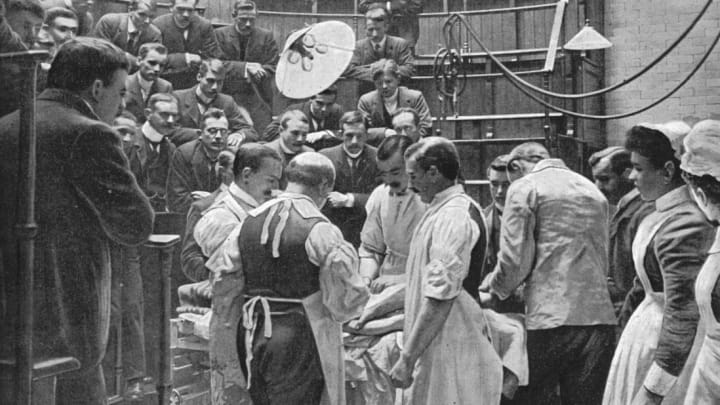9 Strange Things You’d See in a Hospital in 1900
By Editorial Staff

Hospital technology has come a long way since the beginning of the 20th century. These former staples of every ward and operating room have all but disappeared.
1. Street Clothes in Operating Rooms
By 1900, doctors understood that cleanliness in operating rooms was an important part of curbing infection and transmission of germs. Unfortunately for patients, they hadn’t quite mastered the art of creating sterile surgical environments. Surgeons performed procedures in their street shoes and clothes topped little more than a butcher’s apron—not to protect the patient, but to keep their threads from getting too bloody.
2. Bare Hands and Faces
Although rubber gloves had been invented in the 19th century, their use hadn’t really taken off in 1900. Surgeons would give their hands a thorough pre-procedure scrubbing, then get to work with bare hands. Similarly, the surgical face masks that are a common sight today were still decades away from widespread use.
3. Open Operating Theaters
The surgical team wasn’t alone in tracking contaminants into the operating room. Unlike the scrupulously sterilized modern operating rooms, in the 19th and early 20th centuries many procedures took place in large, open-air operating theaters filled with no barrier between the patient and spectators in street clothes. Since early electric lights didn’t always give off enough light for surgery, these operating theaters often included large windows to let in extra sunlight.
4. Hand-Cranked Suction
If a surgeon needs a clear, blood-free look at the area on which an operation is being performed, he or she can use suction to remove blood from the area. In modern operations, this task is performed by electrically powered vacuum systems, but in 1900 it required elbow grease: Typically, one member of the operating team furiously cranked a mechanical suction pump to give the surgeon a clearer view.
5. Inhaled Anesthesia
Being put under for surgery is pretty straightforward for most modern patients: A dose of drugs is administered via IV, and the patient drifts off. In 1900, things weren’t so easy. Inhaled ether was the anesthetic of choice in the early 20th century, and while it did the trick, it soon fell out of favor as more versatile, less flammable intravenous options emerged.
6. Nurses Wearing Caps
Until the 1980s, a small white cap perched atop the head was a part of nursing’s standard uniform. The cap wasn’t just decorative. It kept long hair out of the nurse's way and offered patients a visual cue that the person giving them care was a qualified nurse. However, as nurses transitioned to wearing scrubs rather than formal white uniforms, their signature caps fell by the wayside.
7. Involuntarily Committed Tuberculosis Patients
As tuberculosis tore through New York City during the late 19th century, in 1893 public health officials began an aggressive campaign to curb the spread of the disease. In addition to educating patients on how to prevent further infections, officials could forcibly remove infectious patients from their homes and confine them to hospitals. Although the measure sounds extreme, it worked.
8. Boiling Water Sterilizers
In an early 20th century operating room, you could have spied surgical implements sitting in a pot of boiling water to sterilize them. While this technique was somewhat effective at killing off germs, simple boiling in water can allow some spores to survive. Today, hospitals use a combination of steam and pressure in an autoclave to more thoroughly disinfect implements.
9. Stables
The motorized ambulance made its debut in 1899 when a Chicago hospital adopted an electric version, and the breakthrough found its way to New York City the following year, but the vast majority of emergency patients in 1900 made their way to the hospital in horse-drawn ambulances. Major hospitals had their own specialized stables in which horses’ harnesses dangled from the ceilings. When an emergency call came in, drivers dropped the quick-rigging harnesses onto their team in just seconds and took off for the scene.
Even as automobiles gained in popularity, horse-drawn ambulances persisted. Some of New York’s biggest hospitals were still using them as late as 1923. Public health officials were delighted with the development since it spared them both the hassle of operating stables and the unsanitary conditions that came with quartering livestock in close proximity to patients.